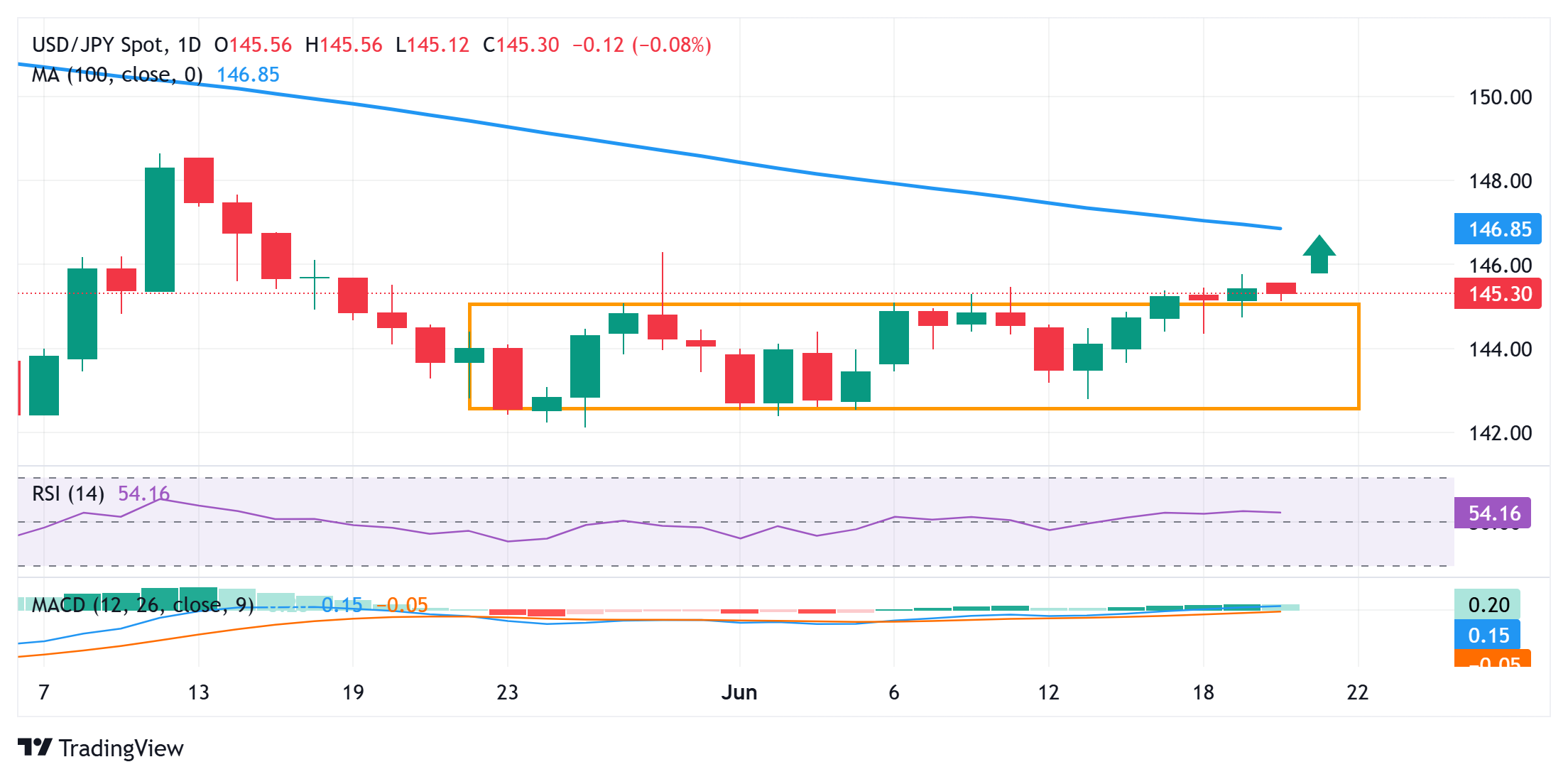
- USD/JPY reversed an intraday dip that followed the release of strong inflation figures from Japan.
- Reduced BoJ rate hike bets undermine the JPY, while the Fed’s hawkish pause supports the USD.
- The Middle East conflict acts as a tailwind for the safe-haven JPY and caps the upside for the pair.
The USD/JPY pair trades flat around the 145.40 area during the Asian session on Friday and remains close to the monthly peak touched the previous day amid a combination of diverging forces. The Japanese Yen (JPY) got a minor lift after a government report showed that Japan’s annual National Consumer Price Index (CPI) remained well above the Bank of Japan’s (BoJ) 2% target in May. In fact, the headline CPI rose by 3.5% YoY in May, compared to the previous reading of 3.6%. Further details revealed that the National core CPI, which excludes volatile fresh food prices, picked up from the 3.5% YoY rate in April and grew 3.7% last month – marking the highest level since January 2023.
Adding to this, a core reading that excludes both fresh food and energy prices, and is closely watched by the BoJ as a gauge of underlying inflation, rose 3.3% YoY in May from 3.0% in the prior month. Stronger CPI prints pointed to broadening inflationary pressures in Japan and gives the central bank more impetus to hike interest rates in the coming months. However, the BoJ earlier this week signaled its preference to move cautiously in normalizing still-easy monetary policy and decided to slow the pace of reduction in its bond purchases from fiscal 2026. Furthermore, the gloomy economic outlook and the uncertainty over US tariffs suggest that the BoJ could forgo hiking interest rates in 2025.
In fact, investors have now pushed back their expectations for the next BoJ rate hike to Q1 2026. This, along with concerns about the potential economic fallout from existing 25% US tariffs on Japanese vehicles and 24% reciprocal levies on other imports, fails to assist the JPY in attracting any meaningful buyers amid a slight recovery in the risk sentiment. However, persistent trade-related uncertainties and rising geopolitical tensions should keep a lid on the market optimism and help limit the downside for the safe-haven JPY. Ahead of the July 9 deadline for sweeping “liberation day” tariffs, US President Donald Trump said earlier this week that tariffs on the pharma sector are coming soon.
On the geopolitical front, the aerial war between Iran and Israel continues for the eighth day as Trump weighs US involvement in the conflict. According to the White House, Trump said that he would give Iran the last chance to make a deal to end its nuclear program and allow two weeks for diplomacy to proceed before deciding on launching strikes. This keeps the risk of a broader Middle East conflict in play and continues to weigh on investors’ sentiment. Apart from this, subdued US Dollar (USD) price action contributes to capping the USD/JPY pair. Nevertheless, spot prices remain on track to register weekly gains on the back of the Federal Reserve’s (Fed) relatively hawkish pause earlier this week.
The US central bank held interest rates steady at the end of a two-day meeting on Wednesday amid concern that Trump’s tariffs could push up consumer prices. In the so-called dot plot, the committee projected two rate cuts by the end of 2025. However, Fed officials forecasted only one 25-basis points rate cut in each of 2026 and 2027 amid the risk that inflation could stay persistently higher. Traders now look to the release of the Philly Fed Manufacturing Index and the Fed Monetary Policy Report to grab short-term opportunities around the USD/JPY pair heading into the weekend.
USD/JPY daily chart

Technical Outlook
This week’s back-to-back close above the 145.00 psychological mark this week and a subsequent strength beyond the previous monthly high, around the 145.45 area, could be seen as a fresh trigger for the USD/JPY bulls. Moreover, oscillators on the daily chart have just started gaining positive traction and suggest that the path of least resistance for spot prices remains to the upside. Hence, a move beyond the 145.75 area, towards reclaiming the 146.00 mark, looks like a distinct possibility.
This is closely followed by the May 29 peak, around the 146.25-146.30 region, above which the USD/JPY pair could aim to challenge the 100-day Simple Moving Average (SMA), currently pegged just ahead of the 147.00 round figure. Some follow-through buying should pave the way for a move towards the 147.40-147.45 intermediate hurdle en route to the 148.00 mark and 148.65 region, or the May monthly swing high.
On the flip side, weakness below the 145.00 psychological mark is more likely to attract fresh buyers and find decent support near the 144.50-144.45 area. The next relevant support is pegged near the 144.00 round figure, which should now act as a strong near-term base for the USD/JPY pair. A convincing break below, however, would negate the positive outlook and shift the near-term bias in favor of bearish traders.
Information on these pages contains forward-looking statements that involve risks and uncertainties. Markets and instruments profiled on this page are for informational purposes only and should not in any way come across as a recommendation to buy or sell in these assets. You should do your own thorough research before making any investment decisions. FXStreet does not in any way guarantee that this information is free from mistakes, errors, or material misstatements. It also does not guarantee that this information is of a timely nature. Investing in Open Markets involves a great deal of risk, including the loss of all or a portion of your investment, as well as emotional distress. All risks, losses and costs associated with investing, including total loss of principal, are your responsibility. The views and opinions expressed in this article are those of the authors and do not necessarily reflect the official policy or position of FXStreet nor its advertisers. The author will not be held responsible for information that is found at the end of links posted on this page.
If not otherwise explicitly mentioned in the body of the article, at the time of writing, the author has no position in any stock mentioned in this article and no business relationship with any company mentioned. The author has not received compensation for writing this article, other than from FXStreet.
FXStreet and the author do not provide personalized recommendations. The author makes no representations as to the accuracy, completeness, or suitability of this information. FXStreet and the author will not be liable for any errors, omissions or any losses, injuries or damages arising from this information and its display or use. Errors and omissions excepted.
The author and FXStreet are not registered investment advisors and nothing in this article is intended to be investment advice.








